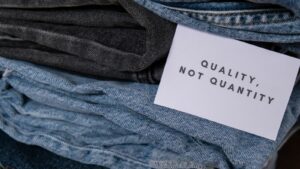In the bustling world of fashion, there’s a new trend that’s more than just a passing fad. Sustainable fashion is reshaping the industry, making headlines, and sparking conversations across the globe. It’s not just about looking good anymore; it’s about feeling good about the choices we make.
Stay tuned as we unravel the threads of this green revolution, exploring the innovations, influencers, and impacts that are setting a new standard for style. It’s a world where fashion isn’t just about the clothes we wear, but the future we’re weaving together.
Sustainable Fashion News

Throughout the year, the fashion industry witnessed numerous instances of sustainable fashion making waves. Paris jumped on the bandwagon, launching a ‘Green Fashion Week’. Eco-conscious designers got the spotlight, showcasing collections made from recycled materials and organic cotton. Meanwhile, New York committed to reducing waste in the fashion industry, organizing a ‘Swap Party’ to encourage clothing exchange amongst fashionistas.
On the innovation front, advancements took place. ‘Lab-grown leather’ emerged as a revolutionary product, backed by research teams who believe in fashion that doesn’t harm animals. In addition, companies like ‘One Green Thread’ started mass-producing ‘biodegradable threads’, a game-changer in the accessories sector.
Impacts of these sustainable trends were evident. Fast fashion behemoths started including eco-friendly lines in their collections, indicating a drastic shift away from their usual practices. Furthermore, consumers responded positively, reflected in the increased demand for clothing created through sustainable means.
The Rise of Sustainable Fashion

Change reverberates through the fashion industry as it inches towards sustainable practices. Ditching plastic-derived fabrics, brands resort to organic cotton, hemp, and even exotic materials like pineapple leaves and mushrooms. Examples of such creative innovations in material sourcing are Pinatex, made from pineapple leaf fibres, and Mylo, a leather alternative derived from mycelium, the root structure of mushrooms.
Brands scrutinize every production process, ensuring minimal waste generation and energy consumption. Exemplifying this is Everlane with its ‘radical transparency’ policy that includes comprehensive details about its supply chain, right from material sourcing to the final product.
Additionally, companies prioritize fair trade policies and safe working conditions. To illustrate, Patagonia discloses its entire manufacturing process, ensuring no child labor involvement and sound working conditions.
The Impact of Sustainable Fashion on the Environment

Sustainable fashion nurtures the environment in multiple ways. It reduces the industry’s water footprint, for instance, as organic cotton demands 71% less water compared to conventional cotton. Moreover, sustainable fashion discourages pollutants. Conventional fashion contributes 10% to global carbon emissions, as The Ellen MacArthur Foundation reports, but sustainability-driven alternatives decrease this impact measurably. Reduction in the disposal of non-biodegradable materials also manifests, as sustainable fashion favors degradable fabrics such as hemp, organic cotton, and lyocell. Opting for these materials significantly curtails landfills’ textile waste, hence minimizing environmental deterioration. Lastly, sustainable practices elevate biodiversity by veering from pesticide-dependent crops to organic ones, ensuring a healthy ecosystem for a variety of species. In essence, sustainable fashion emerges as an environmental ally, diminishing the industry’s ecological impact while enhancing environmental health.
Future Outlook for Sustainable Fashion
Sustainable fashion’s rise is undeniable. It’s not just a trend but a much-needed shift in the industry. As events like ‘Green Fashion Week’ and initiatives like ‘Swap Party’ gain traction, it’s clear that the focus is moving towards eco-conscious choices. Innovations like ‘lab-grown leather’ and ‘biodegradable threads’ are just the beginning. The industry is poised to see more revolutionary changes in the coming years.
Influencers are playing a key role, endorsing eco-friendly brands and driving sales. It’s not just small labels that are benefiting. Even fast fashion giants are feeling the pressure to go green. The environmental benefits are immense, from reducing water footprint to minimizing textile waste.
Sustainable fashion is more than a movement. It’s an environmental ally, leading the charge to ensure a healthier planet. The future of fashion is green, and it’s a future we can all look forward to.

